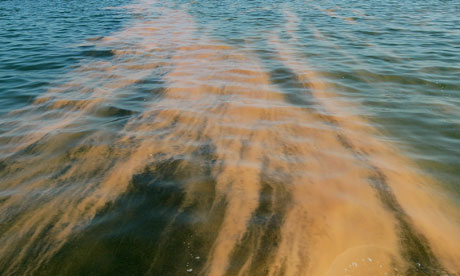This report from the Observer, which references the toxic chemicals being used in an attempt to disperse the gushing oil underwater, is equally depressing. One of the attempted "solutions" may be as bad as the problem, affecting everything from plankton and other microscopic marine life to dolphins, whales, fish and seabirds. not to mention the livelihoods of those who depend on fishing the Gulf.
We should all remember that it is not simply oil fouling the beautiful wetlands and beaches of the Gulf states that is at stake here - it is the entire ecological chain that starts on the floor of the ocean and reaches to the top. We really need to find an alternative to our dependence on oil - and we really need to regulate the oil companies to an extent at least comparable to the size of this ecological disaster.
Louisiana oil spill: toxic chemical fear over BP's clean-up efforts
Officials, scientists and fishermen warn of threat to sealife in the Gulf of Mexico

Chemical dispersant spreads after being released into the Gulf of Mexico this month. Photograph: Joe Raedle/Getty Images
Scientists have raised urgent new concerns over the latest efforts to mitigate the catastrophic oil spill in the Gulf of Mexico caused by the oil rig explosion on BP's Deepwater Horizon. Latest efforts to limit the environmental damage involve an untried deep-water technique, using a toxic dispersant that they believe may damage ocean life. But the new method has so far only succeeded in ratcheting up the growing controversy surrounding the spill.
On Friday, Barack Obama appeared to be losing his patience with oil company executives and officials who have been trading blame since the rig exploded. "I will not tolerate more finger-pointing or irresponsibility," he said in the White House rose garden, flanked by members of his cabinet. "The system failed, and it failed badly. And for that, there is enough responsibility to go around. And all parties should be willing to accept it."
Approval by the US Environment Protection Agency (EPA) for the pumping of tens of thousands of litres of the chemical Corexit 9500 deep on to the seabed early yesterday comes despite warnings fromLouisiana state health officials, scientists and fishermen that the technique is untested and potentially hazardous to marine life and the wider ecosystem. Louisiana officials claim BP and the EPA ignored their concerns about how the chemicals may harm the sea floor.
This round of attempts to both stop the spill and deal with the oil being spewed out follow the failure to capture the leak by the lowering of a 100-tonne metal box over the damaged seabed wellhead.
In the coming days BP will attempt a "junk shot". This involves pumping the damaged blow-out preventer lying on the ocean floor – which failed during the explosion that killed 11 workers – with golf balls and other material to clog it up before closing it with heavy mud.
But it is the use of the chemical dispersant in such depths that has become the increasing focus of concern. Until now, Corexit 9500 has been approved for surface use only.
Chemical dispersants break oil into small globules, allowing it to disperse more quickly into the water or air before currents can wash it ashore.
Corexit 9500 has been identified as a "moderate" human health hazard that can cause eye, skin or respiratory irritation with prolonged exposure. Its makers also warn that it has the tendency to "bioconcentrate" in the environment.
Louisiana health and hospitals secretary Alan Levine said federal regulators have been too quick to dismiss worries about the chemicals: "Our concerns about the use of these dispersants underwater is based on the fact that there is virtually no science that supports the use of those chemicals. We're trading off what we know is going to be environmental damage on the surface for environmental damage of a level we don't know that is going to be under the surface."
Carys Mitchelmore, an environmental chemist at the University of Maryland Centre for Environmental Science and a co-author of a 2005 US National Academies report on dispersants, told Nature: "No one will tell you using dispersants won't have an effect. You're trading one species for another. The long-term effects are really unknown. The dispersant has inherent toxicity. And these oil droplets tend to be the same size as food particles for filter-feeding organisms."
"Dispersants… are toxic to marine life, so there are trade-offs to consider," David Pettit of the Natural Resources Defence Council told theWashington Post last week. "And just because humans can't see oil on the surface doesn't mean it's not still in the water column, affecting marine life from plankton to whales."
Another toxiciology expert, Dr William Sawyer, who has made a presentation to the US lawyers representing environmental and other interests after the spill has added to the concern: "The dispersants used in the BP clean-up efforts, known as Corexit 9500 and Corexit EC9527A, are also known as deodorized kerosene," he told the group. "With respect to marine toxicity and potential human health risks, studies of kerosene exposures strongly indicate potential health risks to volunteers, workers, sea turtles, dolphins, breathing reptiles and all species which need to surface for air exchanges, as well as birds and all other mammals. Additionally, I have considered marine species which surface for atmospheric inhalation such as sea turtles, dolphins and other species which are especially vulnerable to aspiration toxicity of Corexit 9500 into the lung while surfacing."
Meanwhile, concern was mounting that substantial slicks of oil might be on the point of reaching Louisiana's fragile marshlands. TV footage late on Friday from a helicopter flight over Louisiana's barrier islands showed miles of slick being washed by waves through wide passes between islands directly toward the wetlands of Terrebonne Parish.




No comments:
Post a Comment